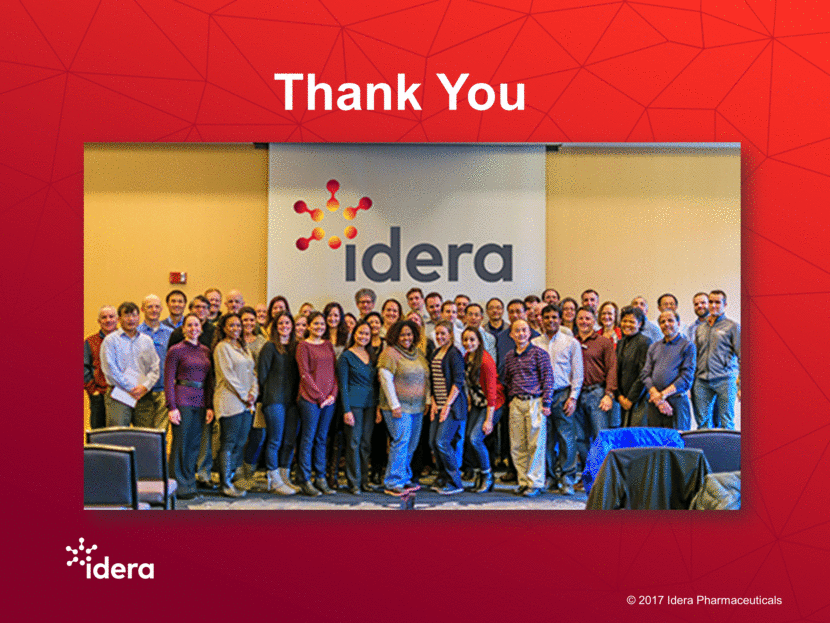Attached files
| file | filename |
|---|---|
| 8-K - 8-K - IDERA PHARMACEUTICALS, INC. | a17-13945_18k.htm |
Exhibit 99.1
May 2017 Corporate Overview © 2017 Idera Pharmaceuticals

Forward Looking Statements and Other Important Cautions This presentation contains forward-looking statements within the meaning of Section 27A of the Securities Act of 1933, as amended, and Section 21E of the Securities Exchange Act of 1934, as amended. All statements, other than statements of historical fact, included or incorporated in this presentation, including statements regarding the Company's strategy, future operations, collaborations, intellectual property, cash resources, financial position, future revenues, projected costs, prospects, plans, and objectives of management, are forward-looking statements. The words "believes," "anticipates," "estimates," "plans," "expects," "intends," "may," "could," "should," "potential," "likely," "projects," "continue," "will," and "would" and similar expressions are intended to identify forward-looking statements, although not all forward-looking statements contain these identifying words. Idera cannot guarantee that it will actually achieve the plans, intentions or expectations disclosed in its forward-looking statements and you should not place undue reliance on the Company's forward-looking statements. There are a number of important factors that could cause Idera's actual results to differ materially from those indicated or implied by its forward-looking statements. Factors that may cause such a difference include: whether interim results from a clinical trial will be predictive of the final results of the trial, whether results obtained in preclinical studies and clinical trials will be indicative of the results that will be generated in future clinical trials, including in clinical trials in different disease indications; whether products based on Idera's technology will advance into or through the clinical trial process on a timely basis or at all and receive approval from the United States Food and Drug Administration or equivalent foreign regulatory agencies; whether, if the Company's products receive approval, they will be successfully distributed and marketed; and such other important factors as are set forth under the caption "Risk Factors" in the Company's Annual Report and on Form 10-K for the period ended December 31, 2016 and on Form 10-Q for the period ended March 31, 2017. Although Idera may elect to do so at some point in the future, the Company does not assume any obligation to update any forward-looking statements and it disclaims any intention or obligation to update or revise any forward-looking statement, whether as a result of new information, future events or otherwise. 2
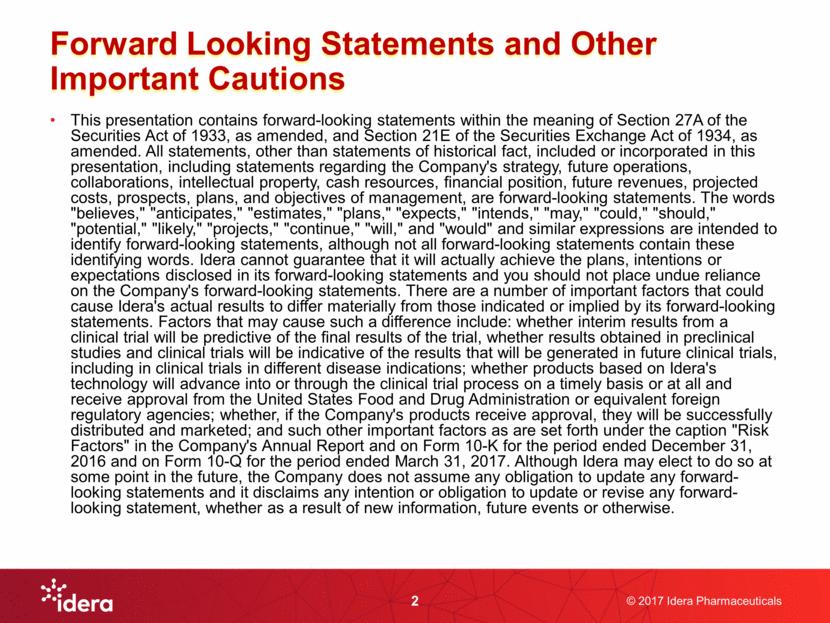
3 Harnessing the Power of the Immune System to Develop Therapies for Unmet Diseases Committed to advancing patient care Advancing Development Pipeline Focused on serious unmet needs in Cancers & Rare Diseases
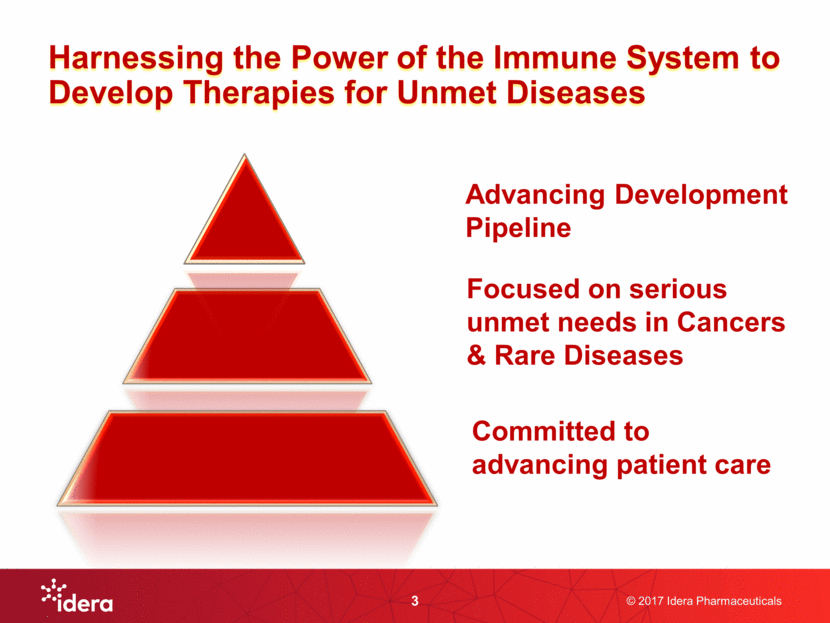
Injecting a New Approach to Immuno-Oncology Activating the Tumor Microenvironment

Checkpoint inhibitor (CPI) therapeutic outcomes are dependent on the Tumor Microenvironment (TME) CPI immunotherapy is effective in multiple tumor types, but in a minority of patients It is believed that patients with non-immunogenic TME fail to respond to CPI therapy Agents which block immuno-regulatory signals or activate the TME are being developed, for example Activate the TME with an intratumoral agent Imlygic (T-vec) has provided the proof-of-concept, and is approved for the local treatment of melanoma* Use of IDO-1 inhibitor in combination with anti-PD-1 has shown encouraging results in multiple tumor types 5 *Imlygic is indicated for the local treatment of unresectable cutaneous, subcutaneous and nodal leasions in patients with melanoma recurrent after initial surgery
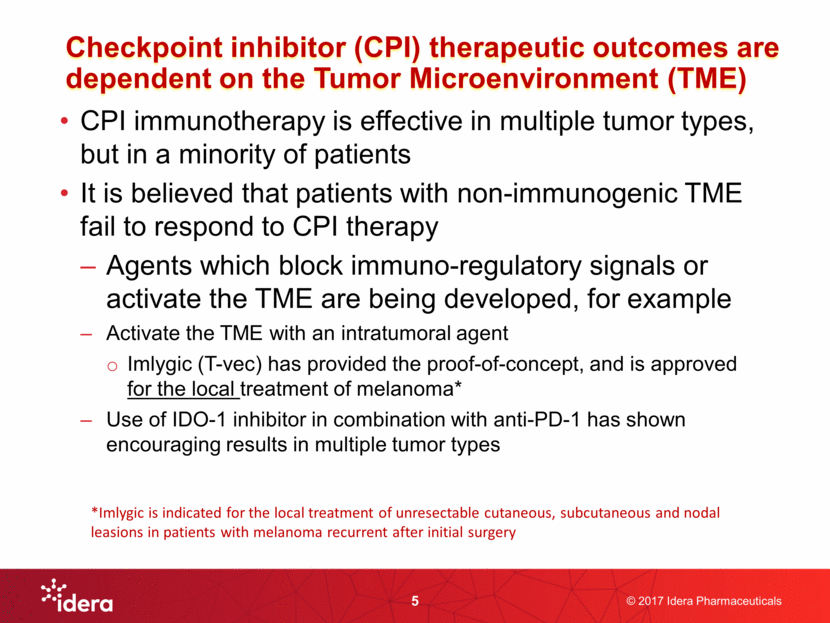
IMO-2125 – A Rationally Designed TLR9 Agonist Our approach is to use intra-tumoral administration of a synthetic TLR9 agonist, IMO-2125 to activate the tumor microenvironment TLR9 is expressed on dendritic cells and B-cells, key cells for innate and adaptive immunity IMO-2125 has shown potent pre-clinical anti-tumor activity in combination with anti-CTLA4, anti-PD1, and IDO-1 inhibitor 1 Use of IMO-2125 avoids oncolytic virus-associated manufacturing and safety issues 6 1 Wang, D, AACR, 2016
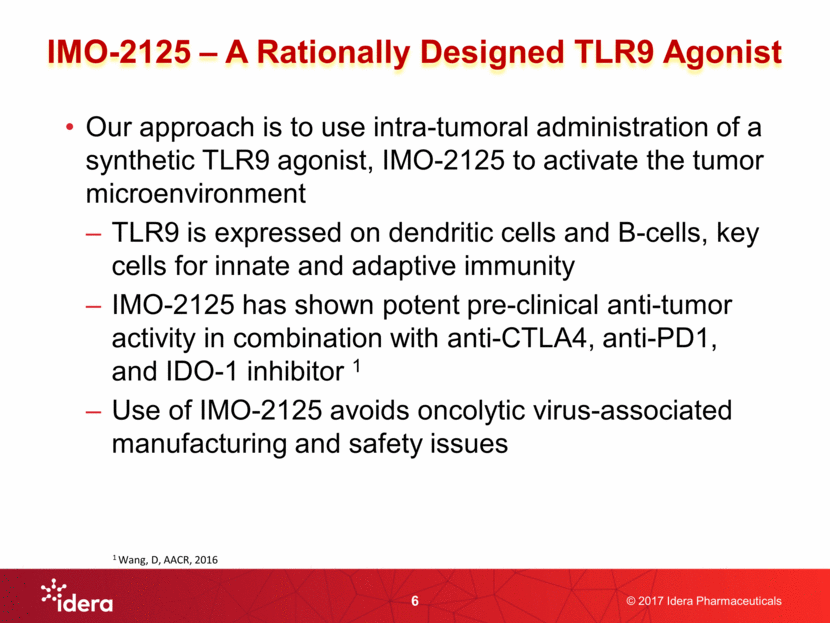
Intra-tumoral IMO-2125 Mechanism of Action 7 Intra-tumoral administration of IMO-2125 Draining Lymph node Primed T-cells migrate to distant tumor sites Metastases are targeted by primed T-cells Increased TIL Infiltration IFN-TLR9 Dendritic Cells Tumor specific antigens NK cells CD8+ T-cells 7
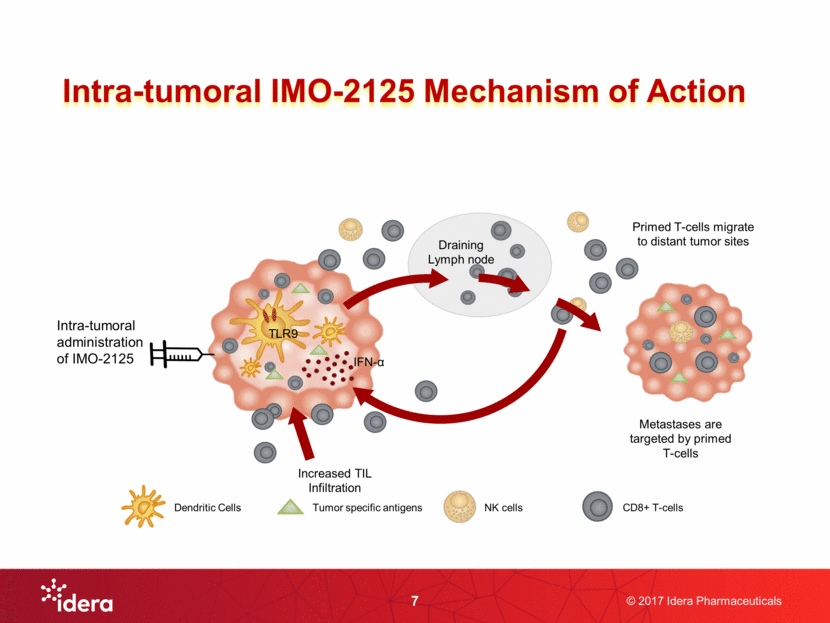
Study 204: POC of IMO-2125 with ipilimumab in PD-1 refractory metastatic melanoma patients Limited options available for patients with melanoma refractory to anti-PD-1 treatment make this a clear unmet medical need Imlygic is not indicated in this setting Ipilimumab monotherapy provides 13% ORR1 IMO-2125 in combination with ipilimumab in PD-1 refractory melanoma patients, provides a fast-to-market opportunity Key phase 1 objectives have been achieved Translational studies confirm mechanism of action of IMO-2125, laying the foundation for broad applicability IMO-2125 administered with ipilimumab at escalating doses without DLT 8mg dose selected for further development, with ipilimumab Encouraging and durable clinical activity observed, including CR Phase 2 expansion now accruing, with additional centers 8 1 Long GV, SMR, 2016
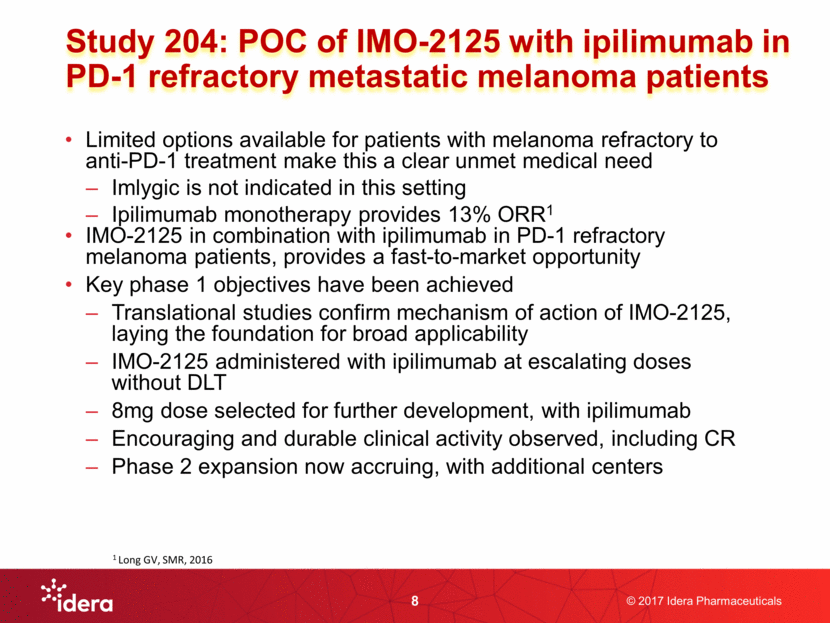
Fresh flow cytometry Formalin - IHC RNA (TCRseq and Nanostring) Tumor biopsy mDC1 vs mDC2 vs pDC CD8 T cell : Treg ratio T cell proliferation via Ki67 of both Tregs and CD8+ T cells Immune subsets ratio (T cell vs B cell vs NK cells) = IMO-2125 = Ipilimumab = Biopsy = Response Assessment Injected / Un-injected lesions Injected lesion Both lesions 1 2 3 4 5 6 7 8 9 11 10 12 13 14 Optional Immune response measurements 6 Study 204: Phase 1/2 study of intra-tumoral IMO-2125 in combination with ipilimumab or pembrolizumab in patients with metastatic melanoma following prior PD-1 directed therapy NCT02644967
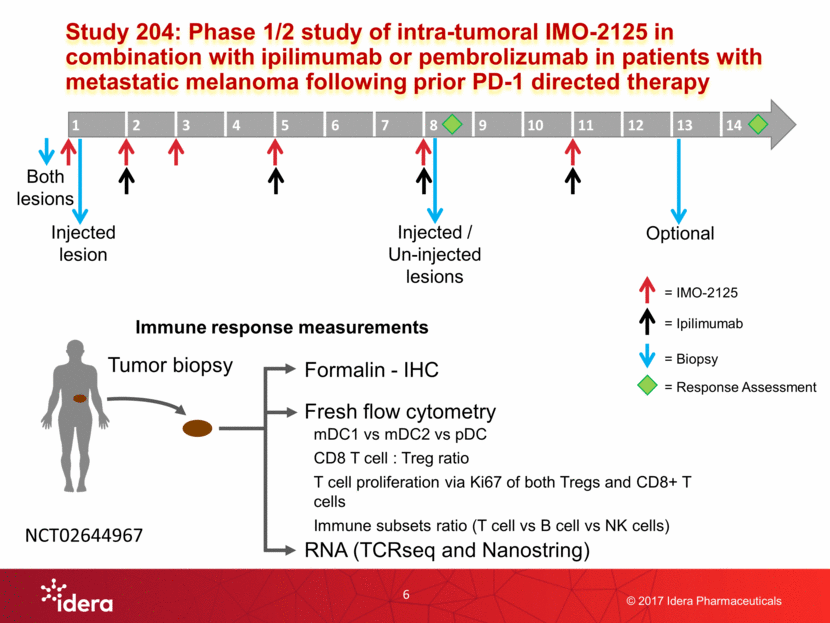
10 Durable Responses with Prolonged Stabilization of Disease
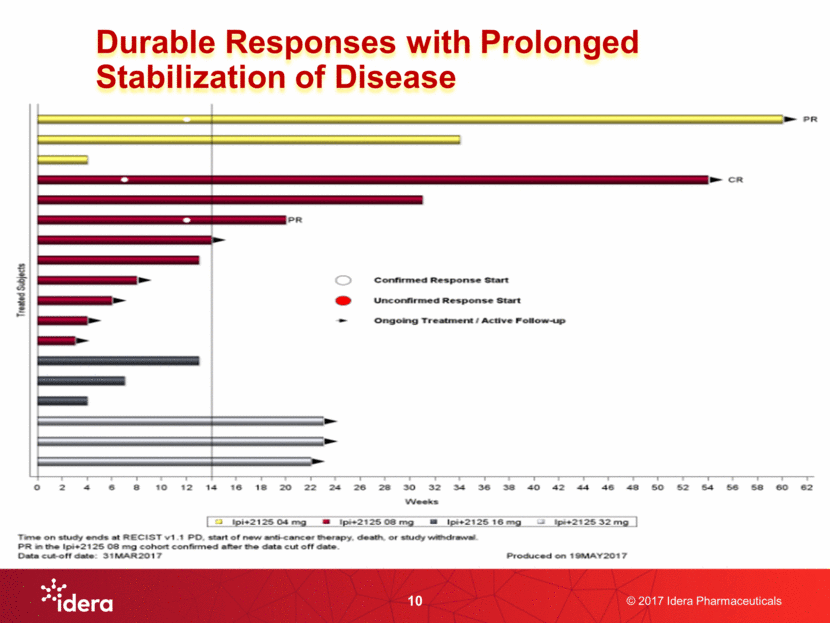
Demonstration of Clinical and Translational Responder 58 y/o WM with BRAF wild-type melanoma originating base of penis Metastases to inguinal lymph nodes and liver Rapid progression on nivolumab (4 cycles) prior to enrollment Received 6 doses IMO and 3 doses ipi (last one held for hypophysitis) Well-known AE deemed related to ipi Patient 003 – 4mg IMO-2125 Cohort 11 Patient Remains PR Over 1 Year
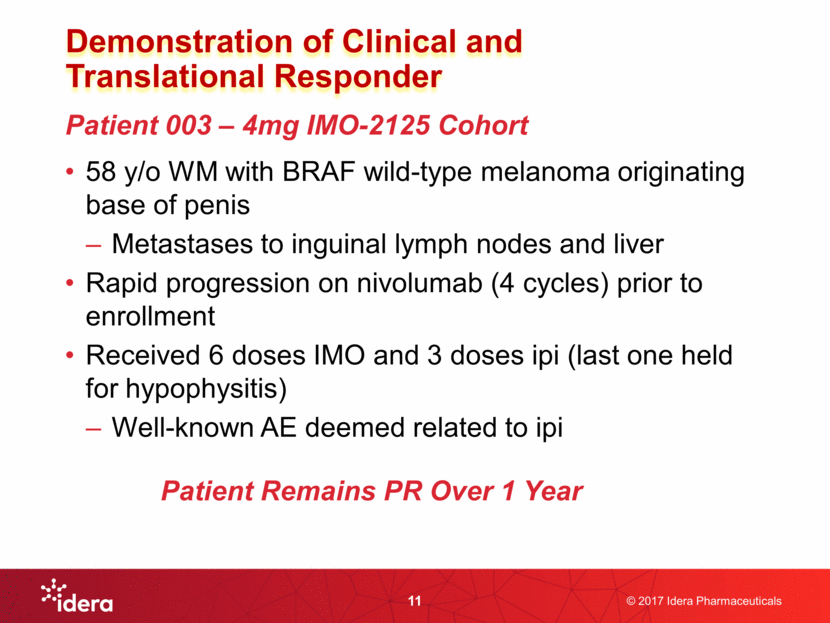
DC Maturation in the Injected Tumor Patient 003 – 4mg IMO-2125 Cohort 12 Graphical representation Pre-dose 24 hours post i.t. IMO-2125 injection IMO-2125 IFN-and Th1-type immune response T-cells mDCs B-cells Macrophages Neutrophils NK cells Migration and expansion of T-cells pDCs B-cells pDCs Blockade with CPIs
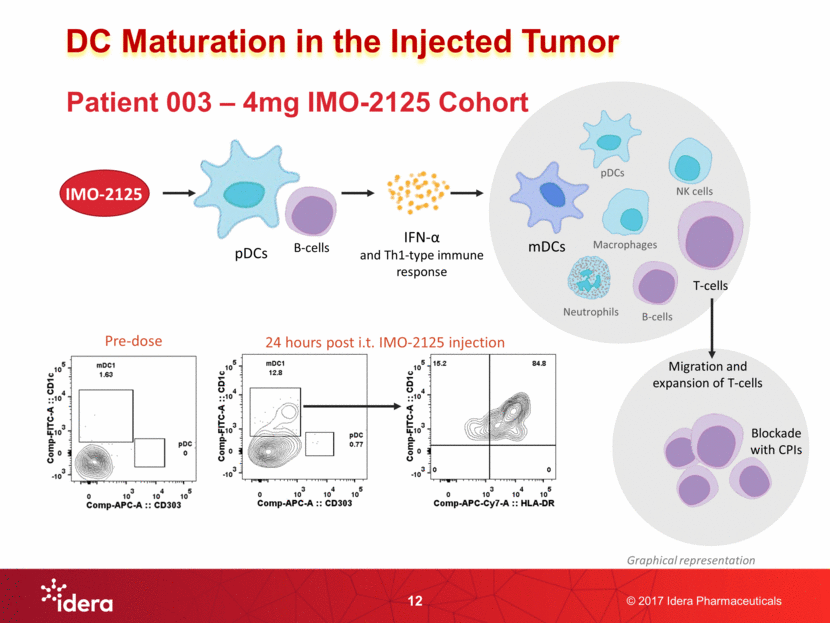
IMO-2125 IFN-and Th1-type immune response T-cells mDCs B-cells Macrophages Neutrophils NK cells Migration and expansion of T-cells pDCs B-cells pDCs Blockade with CPIs T-cell Activation Occurring in the Injected and Distant Tumor Patient 003 – 4mg IMO-2125 Cohort Graphical representation Injected Tumor Distant Tumor CD45+ cells CD56+ of CD8+ cells Ki67+ of CD8+ cells CD45+ cells 10
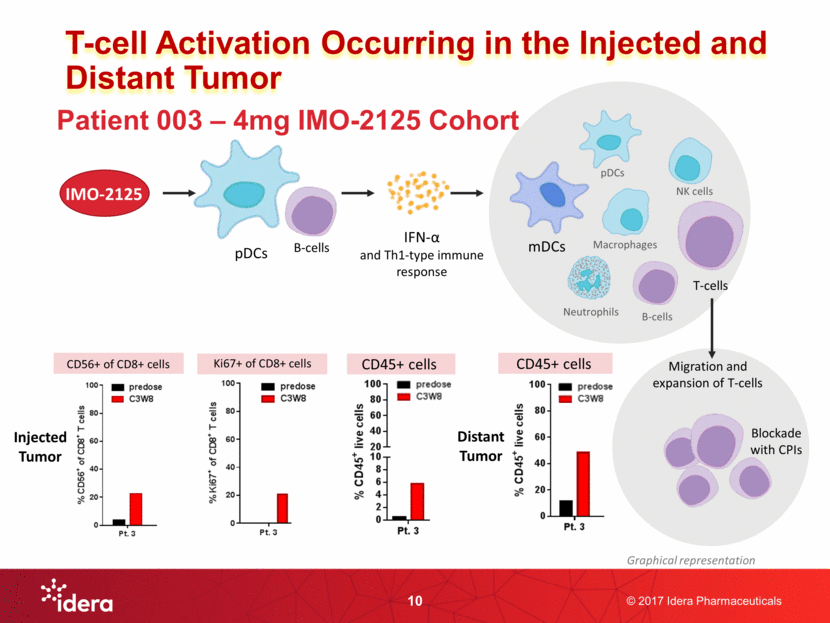
IMO-2125 IFN-and Th1-type immune response T-cells mDCs B-cells Macrophages Neutrophils NK cells Migration and expansion of T-cells pDCs B-cells pDCs Blockade with CPIs 14 Non-responding patient Responding patient predose C3W8 Frequency of total T cell clones predose C3W8 Frequency of total T cell clones Expansion of top T-cell clones in the distant lesions, induction of IFN-Patient 003 – 4mg IMO-2125 Cohort IFN-Patient 003 Remains PR over 1 Yr.
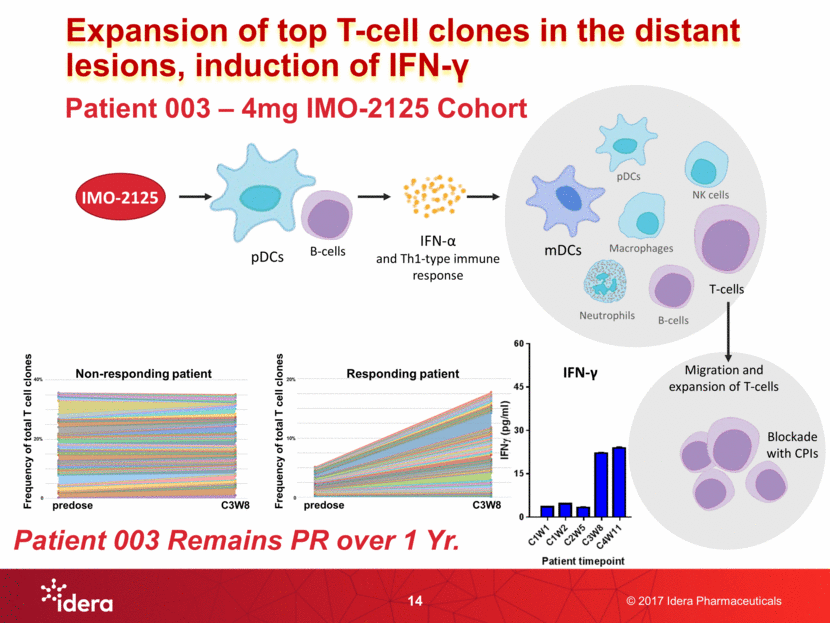
Additional Clinical Responder Case Study 68 y/o male with BRAF wt melanoma, metastatic to lung (bulky), pleura, LN, widespread soft tissue Marked progression on Nivo + Urelumab (anti-4-1BB) Marked progression w/ severe dyspnea Referred to hospice Pleural effusion drained, then begun on study treatment Received 6 doses IMO + 4 doses ipi Dramatic response after 6 wks of therapy RECIST CR at 5 months Patient 004 – 8mg IMO-2125 Cohort 15
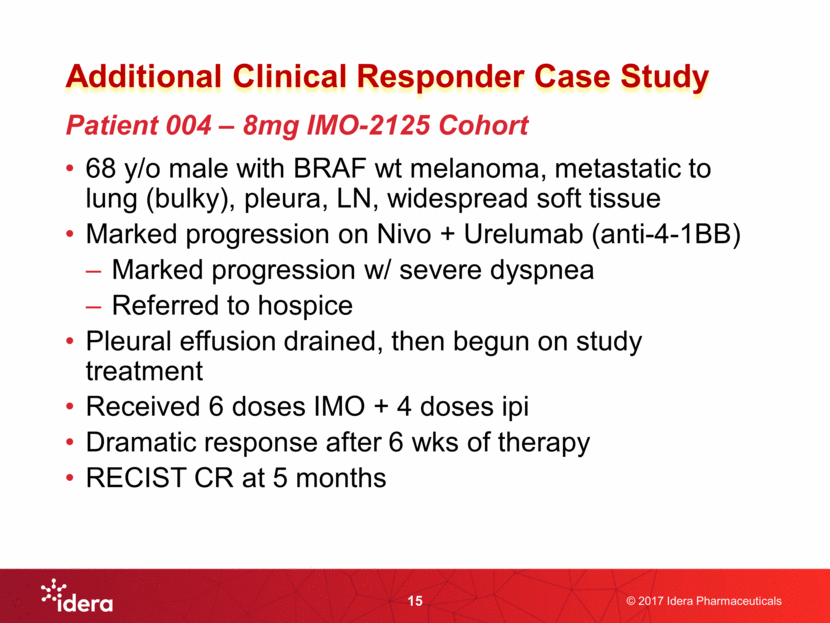
Post-Therapy 08/2016 Pre-Therapy 03/2016 Injected Lesion Distant Lesions Tumor Imaging: Patient 004 Remains a CR at 1 Year Ipilimumab 3mg plus i.t. IMO-2125 8 mg 13
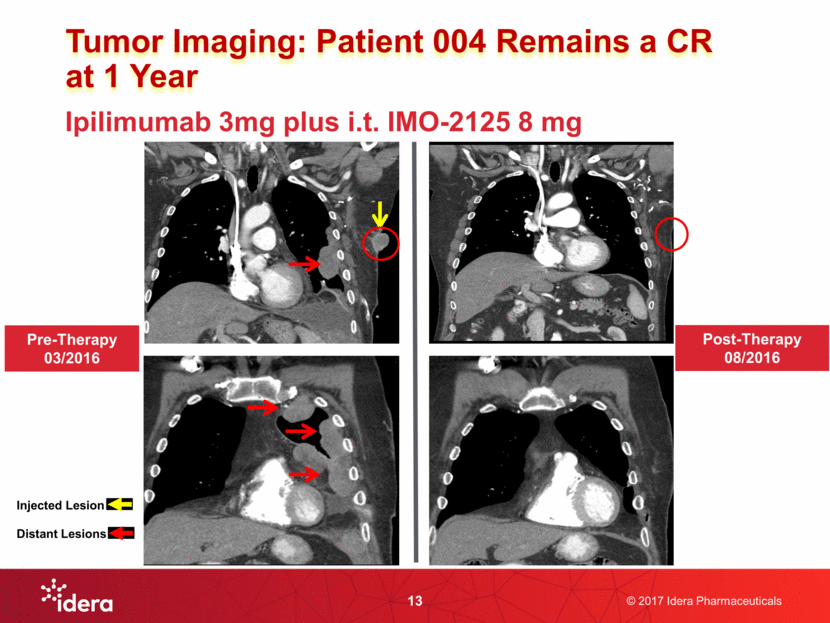
IMO-2125 with ipilimumab in PD-1 Refractory Melanoma - Path Forward Significant clinical momentum 8mg dose of IMO-2125 selected for further development with ipilimumab (April 2017) Seamless initiation of phase 2 portion of study 204 Stage 1 futility hurdle met, now accruing to planned N=21 9 patients from Phase 1 will be included in ph 2 analysis Regulatory interactions ongoing EOP1 meeting with FDA (Q1) Phase 3 planning underway Multiple data presentations ASCO-SITC February data cut presented Phase 2 ORR (Overall Response Rate) data expected Q1 2018 Next planned data presentation – ESMO 2017 (Sep.) 17
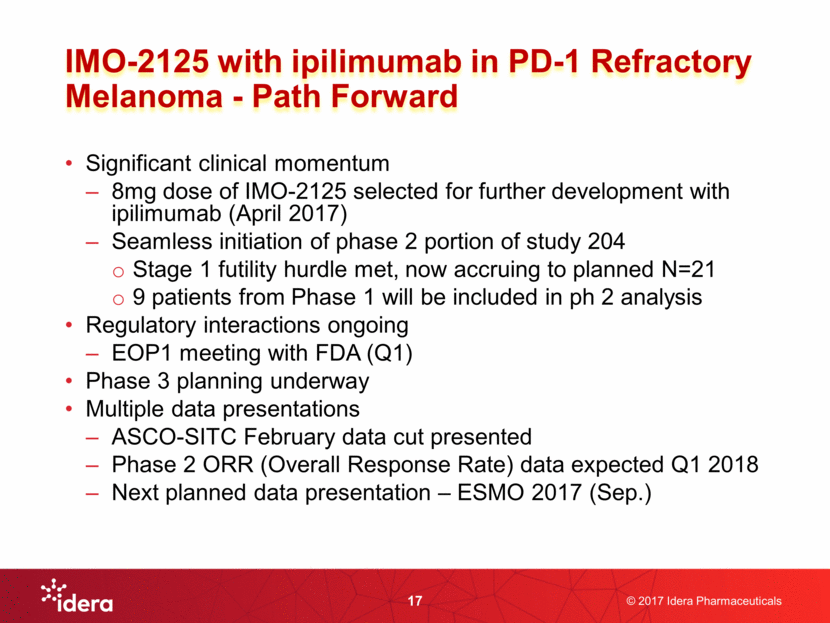
IMO-2125 Beyond Melanoma Mechanism of Action Supports Broader Expansion 18 18 To further capitalize in 2017 we: Continue to enroll study 204 phase 1 IMO-2125/ pembrolizumab combination arm in PD1-refractory metastatic melanoma patients Initiated phase 1 monotherapy trial in all-comer refractory patient population (NCT03052205) Critical for registration and exploratory purposes Plan to initiate phase 2 “umbrella” study – 2H Multiple CPI combos, multiple tumor types Multiple discussions underway for potential clinical development partnerships
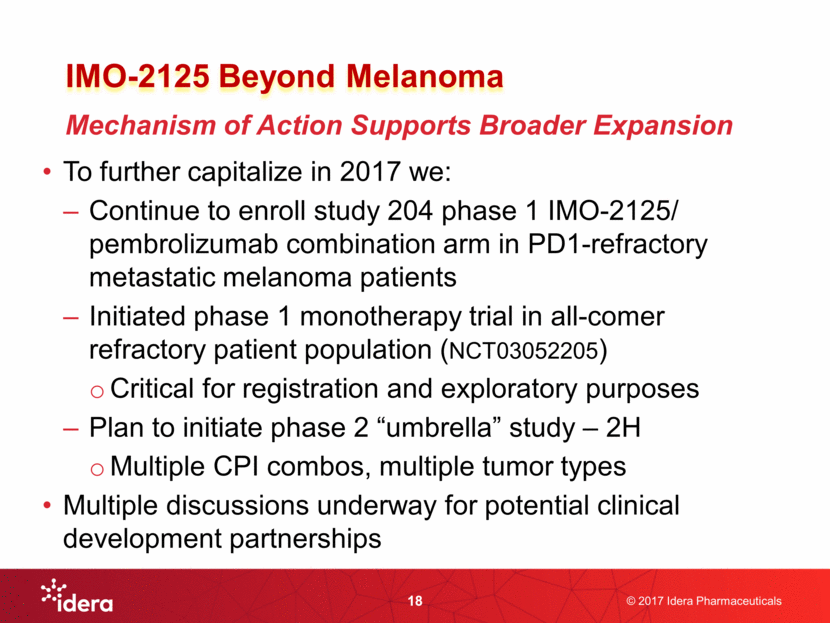
Long-term Expansion Opportunity Significant Introduce Expand Transform Unresectable metastatic melanoma Maturing I/O market primed for combo High unmet need in anti-PD1-refractory patients Emerging I/O addressable tumors “Cold” tumors unaddressable with current I/O Moderate response to cornerstone anti-PD1 Increasing number of approved settings Significant opportunity in tumors with: Low mutation load Low dendritic cell infiltration Bioinformatics research ongoing to identify attractive tumor targets Est. U.S. addressable patient population at 20251 1 Proprietary Idera Commercial Research 2 NSCLC, head and neck, RCC and bladder only 19 19 Est. U.S. addressable patient population at 20251,2 160,000 19 20,000 13,000 1L PD1-refractory 70,000 1L PD1-refractory
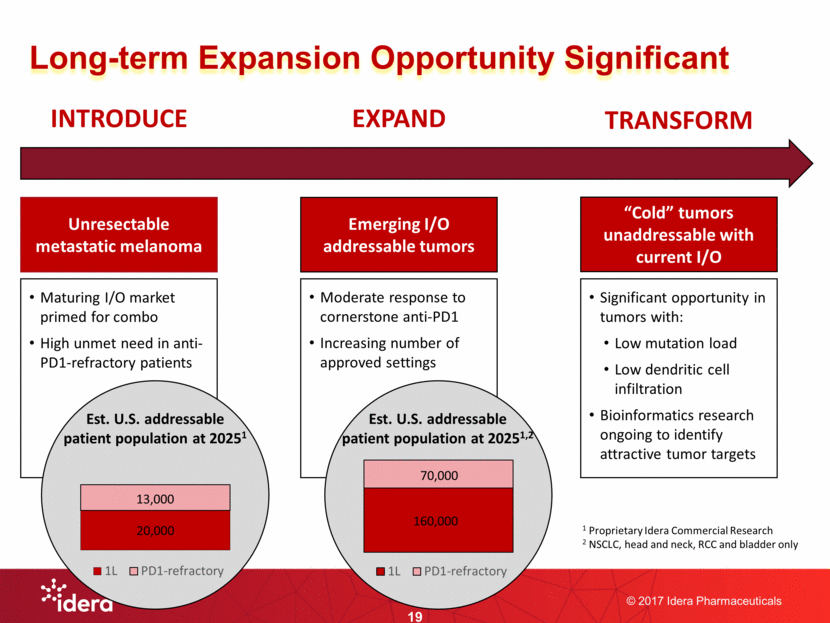
Developing a Targeted Treatment Option for Dermatomyositis with IMO-8400
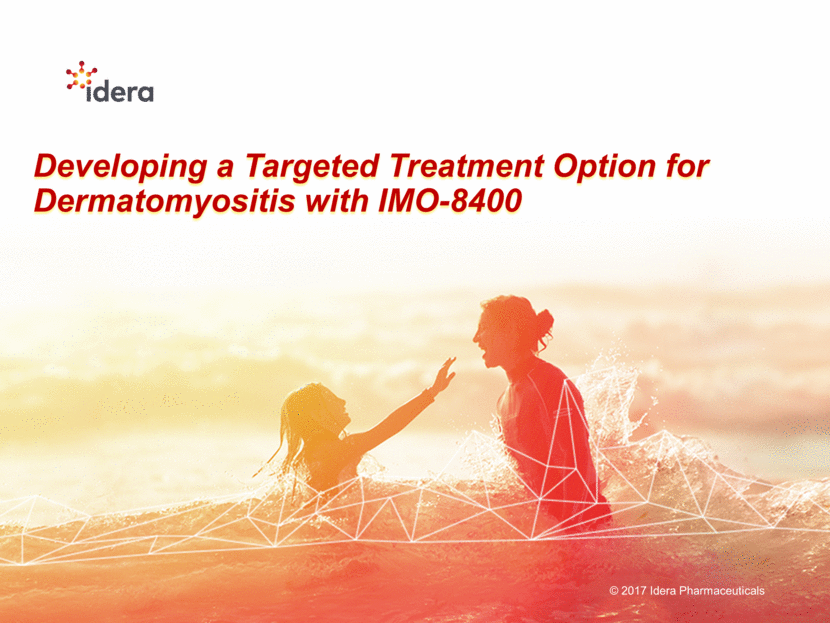
Dermatomyositis (DM) Rare, debilitating, inflammatory condition associated with increased risk of pre-mature death Multisystem disorder affecting both skin and muscle Twice as common in women as men Affects roughly 25K adults in the U.S. Current treatments have limited efficacy and serious side effects 21
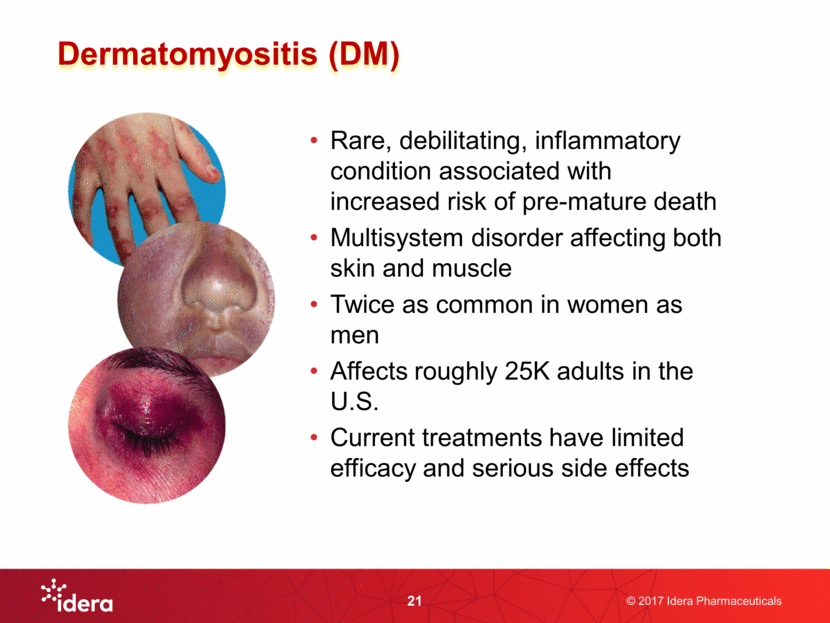
22 Toll-like Receptors in Dermatomyositis
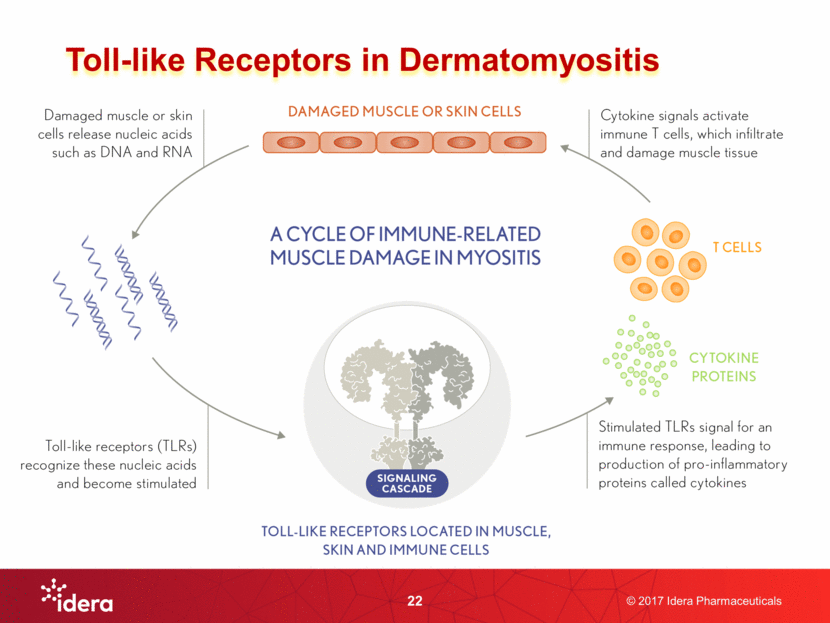
The Role of Toll-like Receptors in DM 23 1 Kim, et al. Clin Rheumatol, 2012. 2 Reed, et al. Arthritis & Rheumatism, 2012. TLR Activation Certain TLRs are over-expressed in the muscles of patients with dermatomyositis Cytokine Expression Expression of certain TLRs has been correlated to the expression of certain cytokines, which are proteins involved in immune signaling1 Disease Activity Cytokine expression has been correlated to changes in disease activity, including the IMACS physician global assessment2
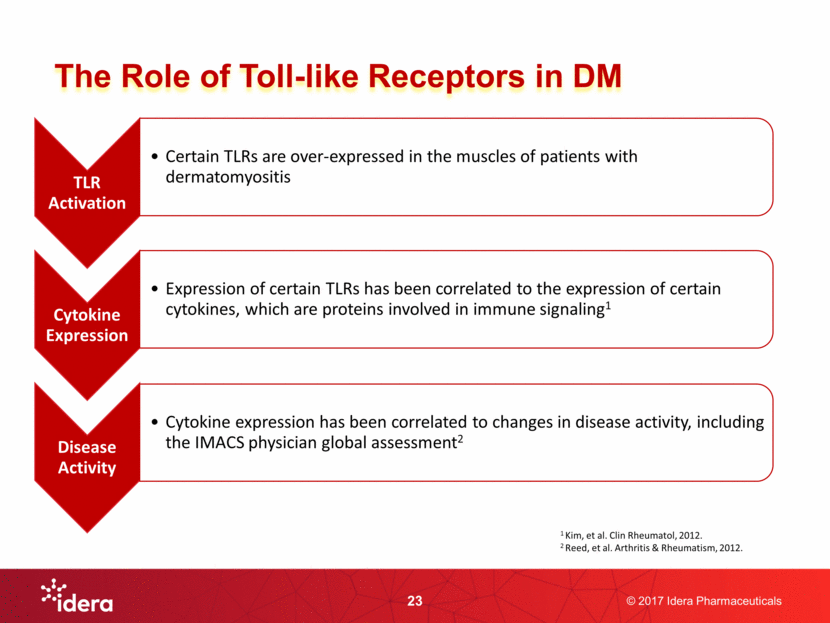
IMO-8400 IMO-8400 is a synthetic oligonucleotide-based antagonist of Toll-like receptors (TLRs) 7,8 and 9 IMO-8400 is designed to inhibit, or antagonize, specific TLR activity Treatment is administered subcutaneously Clinical proof of concept previously demonstrated in clinical trial in Psoriasis To date, IMO-8400 has been studied in over 100 patients and has been generally well-tolerated 24
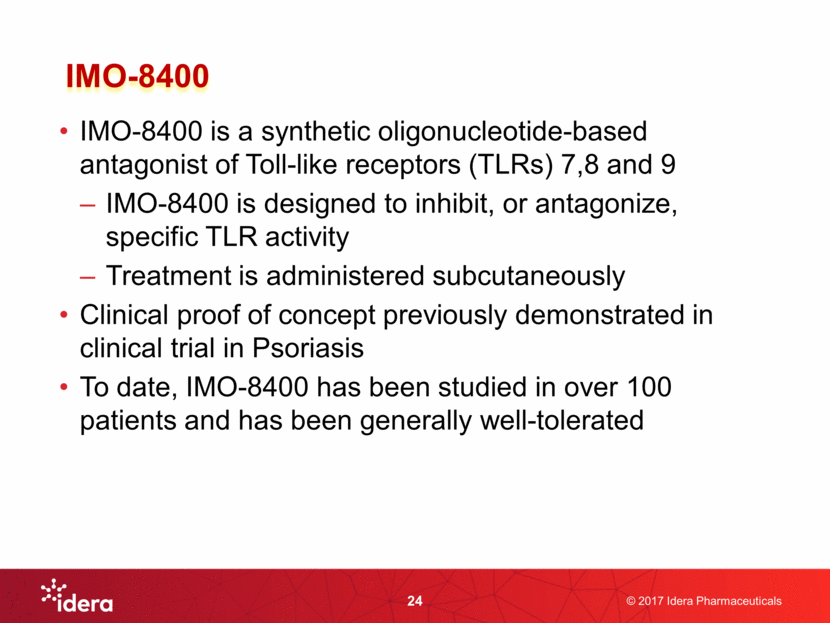
Trial Data Expected 1st Half of 2018 25 PIONEER is a Phase 2, double-blind, placebo-controlled study for adults with dermatomyositis currently experiencing symptoms of active skin disease Target Enrollment: 36 patients through 22 sites in US, UK, and Europe (current underway) Objectives: Investigate impact of IMO-8400 on skin and muscle symptoms of disease, as well as safety and tolerability, antibody profiling, and identifying dose for further development Dosing: 1x/week, via subcutaneous injection, up to 24 weeks 36 patients randomized Placebo IMO-8400 – 1.8 mg/kg IMO-8400 – 0.60 mg/kg 22 sites in US, UK, Europe
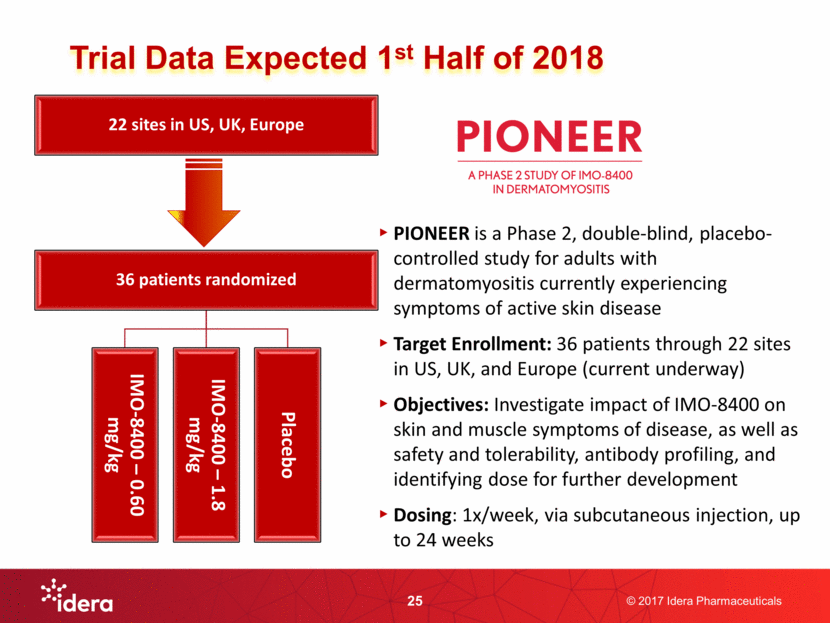
- Third Generation Antisense (3GA)

Why is a better RNA-directed technology needed? 3GA may realize the full potential of antisense technology for the treatment of diverse diseases 3GA designed to overcome the limitations of the first and second generation antisense technology: Immunotoxicities Therapeutic Index Current RNA-focused Platform Technologies Remain Flawed Assays were conducted with antisense constructs in Hepa 1-6 cells; RNA levels were quantified by qPCR % PCSK9 mRNA Expression 27 27
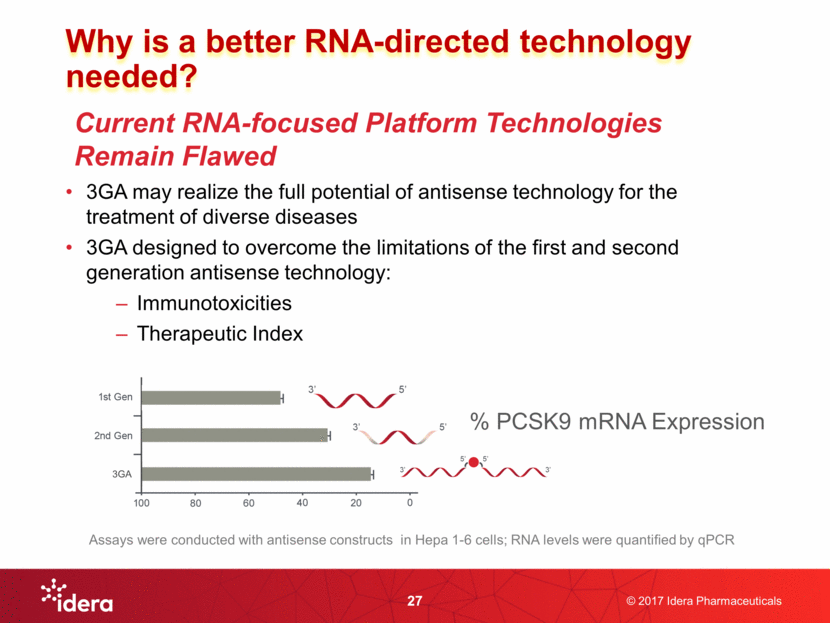
3GA Development to Date Therapeutic areas range across: Rare diseases, oncology, autoimmune disorders, metabolic conditions, single-point mutations, etc. Ongoing activity ranges from cell culture through IND-enabling toxicology Current portfolio feeds potential for both internal development candidates and partnering opportunities 22 3GA Compounds Developed to Specific Gene Targets Across Wide Variety of Therapeutic Areas 28 1st Clinical Candidate for Idera Development Selected
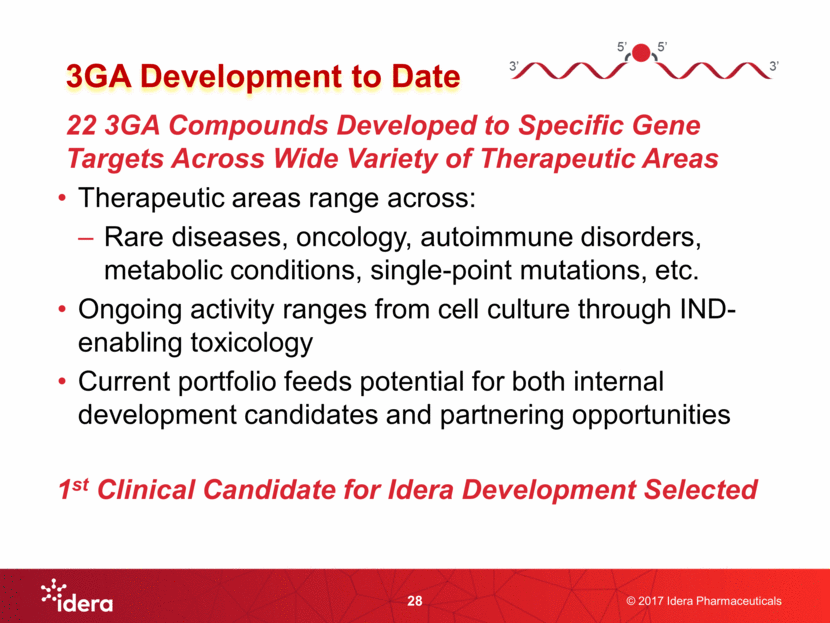
First 3GA Candidate Selected to Enter Clinic For strategic and competitive purposes, Idera to withhold naming selected target until 2H 2017 Well-established liver Target Available pre-clinical animal models Well-known clinical endpoints Potential for broad and rare disease applications Potential Value Drivers Establishment of human proof of concept for platform in 2018 Potential differentiation from other RNA-based therapeutic platforms Opportunity to Validate Technology Platform / Advance Into Late Stage Development 29
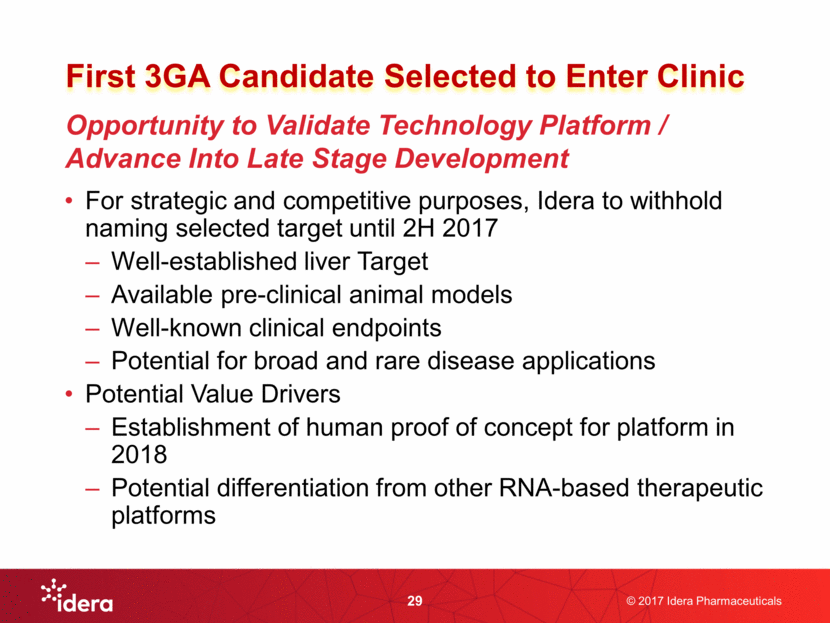
30
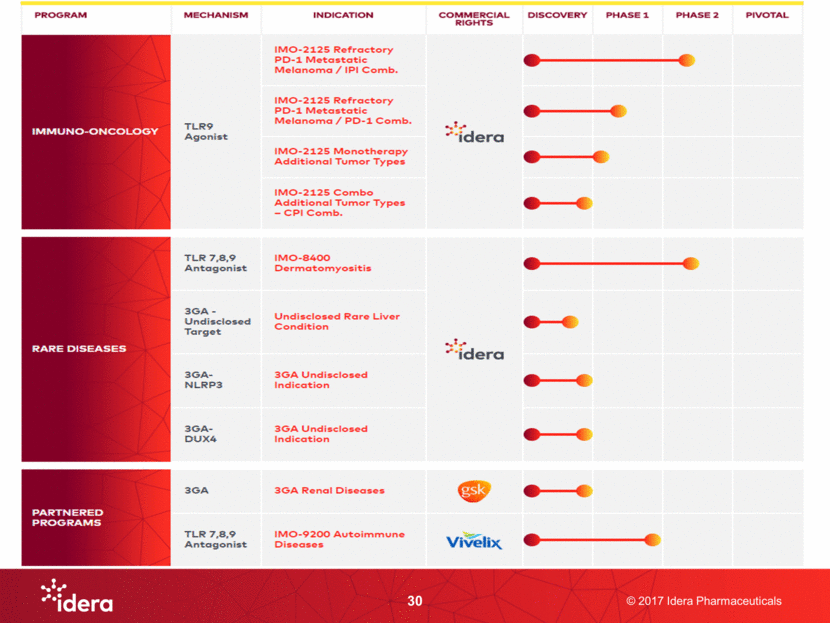
Near Term Expected Deliverables R&D Day Planned for Second Half of 2017 31 IMO-2125 Data Updates and Major Medical Meetings Throughout 2017 Q1 2017 – Initiate Phase 1 IMO-2125 Monotherapy in Multiple Refractory Solid Tumors Clinical Trial 2H 2017 – Enroll IMO-2125 Phase 2 Expansion in Ongoing Clinical Trial 2H 2017 – Initiate Phase 2 IMO-2125 Combination Trial in Multiple Refractory Solid Tumors Clinical Trial 2H 2017 – Complete Enrollment of IMO-8400 Dermatomyositis Trial 2H 2017 – Announce Undisclosed 3GA Development Target and Plan Q1 2018 – File IND for First 3GA Compound Q1 2018 – Initiate and Enroll First 3GA Clinical Trial
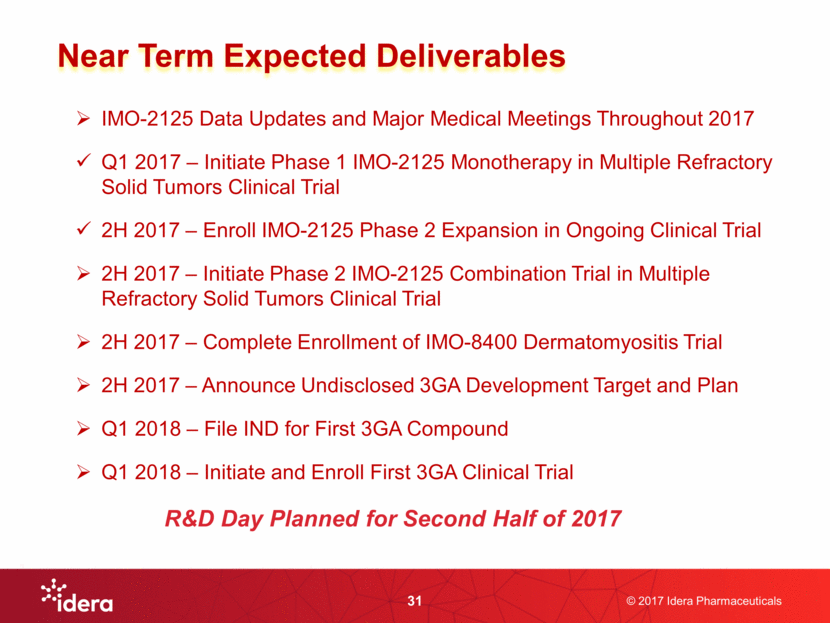
Thank You
